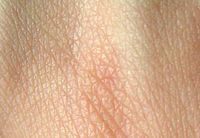
Photo from wikipedia
Abstract Objectives To evaluate osteogenic markers and alveolar ridge profile changes in guided bone regeneration (GBR) of chronic noncontained bone defects using a nonresorbable TiO2 block. Materials and Methods Three… Click to show full abstract
Abstract Objectives To evaluate osteogenic markers and alveolar ridge profile changes in guided bone regeneration (GBR) of chronic noncontained bone defects using a nonresorbable TiO2 block. Materials and Methods Three buccal bone defects were created in each hemimandible of eight beagle dogs and allowed to heal for 8 weeks before GBR. Treatment was assigned by block randomization: TiO2 block: TiO2‐scaffold and a collagen membrane, DBBM particulates: Deproteinized bovine bone mineral (DBBM) and a collagen membrane, Empty control: Only collagen membrane. Bone regeneration was assessed on two different healing timepoints: early (4 weeks) and late healing (12 weeks) using several immunohistochemistry markers including alpha‐smooth muscle actin (α‐SMA), osteopontin, osteocalcin, tartrate‐resistant acid phosphatase, and collagen type I. Histomorphometry was performed on Movat Pentachrome‐stained and Von Kossa/Van Gieson‐stained sections. Stereolithographic (STL) models were used to compare alveolar profile changes. Results The percentage of α‐SMA and osteopontin increased in TiO2 group after 12 weeks of healing at the bone‐scaffold interface, while collagen type I increased in the empty control group. In the defect area, α‐SMA decreased in the empty control group, while collagen type I increased in the DBBM group. All groups maintained alveolar profile from 4 to 12 weeks, but TiO2 group demonstrated the widest soft tissue contour profile. Conclusions The present findings suggested contact osteogenesis when GBR is performed with a TiO2 block or DBBM particulates. The increase in osteopontin indicated a potential for bone formation beyond 12 weeks. The alveolar profile data indicated a sustained lateral increase in lateral bone augmentation using a TiO2 block and a collagen membrane, as compared with DBBM and a collagen membrane or a collagen membrane alone.
Journal Title: Clinical Implant Dentistry and Related Research
Year Published: 2022
Link to full text (if available)
Share on Social Media: Sign Up to like & get
recommendations!